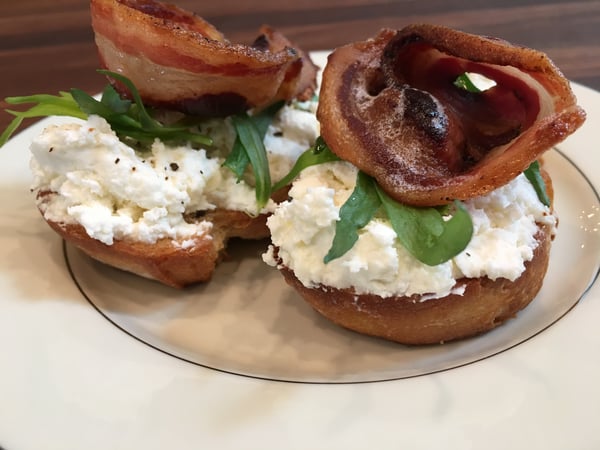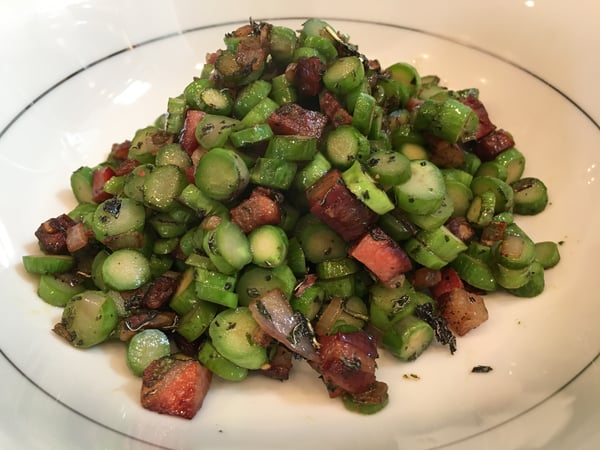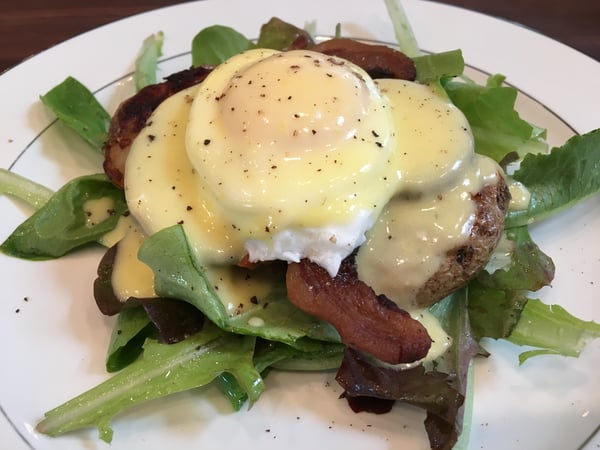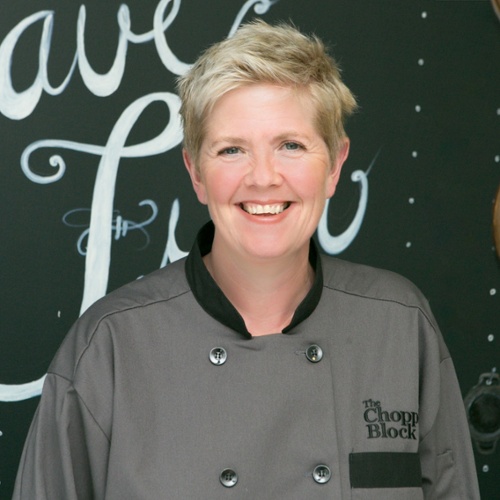Now that you know how to make pancetta, I wanted to provide a few tips on cooking with it and recipes that highlight those techniques. Although pancetta is edible in the same way bacon is, its high fat content doesn’t give it a particularly appealing texture, so I much prefer my pancetta crispy.
Pancetta can be diced and crisped in a sauté pan. Many recipes call for adding a little oil to the pan first because it takes a minute for some of the fat to render out and the oil helps the pancetta not burn or scorch in the pan. Another option is to add a little water, let the water evaporate, and render out some of the fat then finish crisping up the pancetta. My favorite method is to start the skillet on a low temperature and slowly render out some of the fat then turn the heat up to finish crisping.
If you want crispy pancetta slices, more like bacon, you can cook the slices in a skillet, again starting with a lower heat and turning up after some of the fat renders out. The pancetta tends to curl which can look pretty cool but is a little more challenging to get crispy all over.
Another method is to take a sheet pan and line it with parchment, then lay the pancetta slices on the parchment. Put another piece of parchment on top of the pancetta and lay a sheet pan on top of that. Bake at 400 for about 20 minutes or until crispy. This keeps the pancetta slices flat and more evenly crisps it.
Now that you have some beautifully crisp pancetta, what should you do with it? I thought of sharing what is arguably the most famous dish with pancetta, Pasta Carbonara but decided against that. There are a lot of great recipes for Carbonara but there are not a lot of others featuring pancetta so I created a few for you.

Once you have cooked your pancetta you have a beautiful skillet of fat left. This fat is just as important as the meat and generally used in recipes featuring pancetta. For this bruschetta, I took some sliced baguettes and toasted them in the pan with the fat, which made them so delicious and rich! Once you have the bread ready you can top it with any number of toppings but here I used fresh ricotta with a sprinkle of salt and pepper, tarragon leaves and pancetta curls. I think a drizzle of balsamic reduction or Cream of Balsamic would be delicious too.

This is my take on the classic peas and pancetta. I diced about 2 ounces of pancetta and crisped that up, added 1 minced shallot and 1 bunch of asparagus cut into tiny coins and turned the heat up to medium high. Sauté until asparagus is just tender, 3 to 5 minutes. Season with pepper and a 1 to 2 teaspoons of fresh mint or tarragon. This dish may not need any additional salt since the pancetta is so salty, so taste before you add.

In this dish, I used pancetta that I crisped in the oven. I saved the fat from the pan and put that into a skillet. I microwaved a potato on the small side until tender and then smashed it a little bit. I put the potato into the pan with the pancetta fat and cooked until crispy. While the potato is crisping, start the poaching water for the eggs (see our video on how to poach eggs). I then made my Hollandaise sauce (I have another video for that). Put an egg into the poaching liquid and then toss a simple salad together. I tossed a few mixed greens with a splash of good vinegar, olive oil and a pinch of salt. Place the greens on a plate, top with the crispy potato, then the pancetta, poached egg and finally top with the Hollandaise.
You can find these kinds of essential techniques and approachable recipes in all of The Chopping Block's cooking classes. Keep checking our online video library when you can't make it to class or when you need a refresher course!












